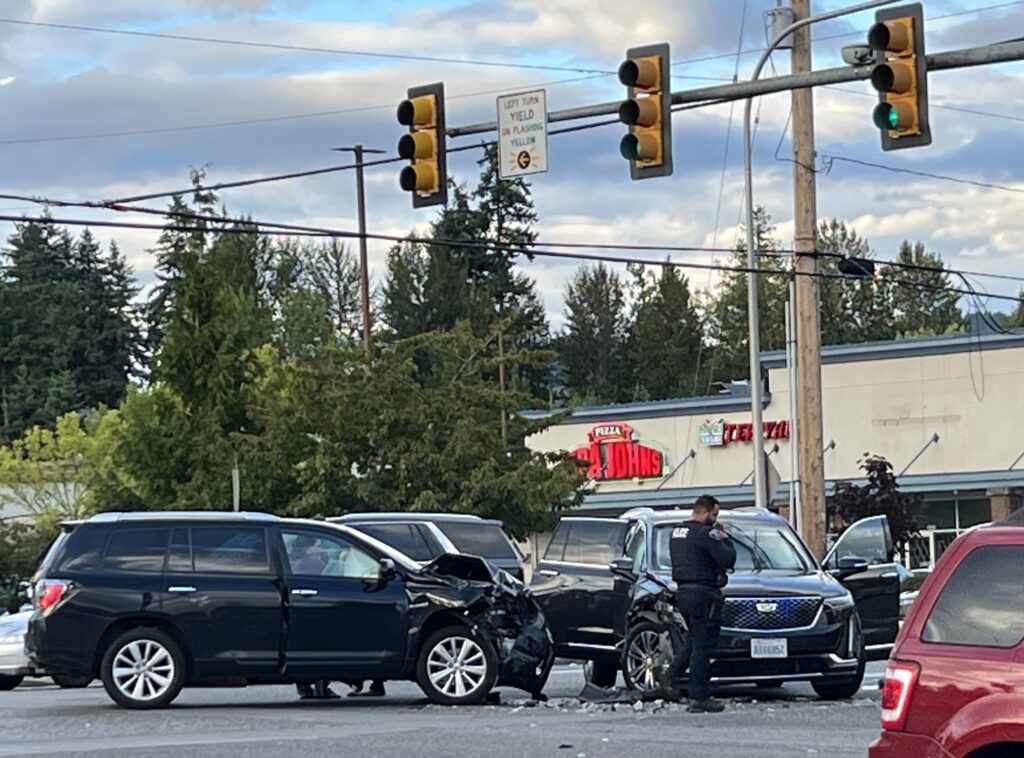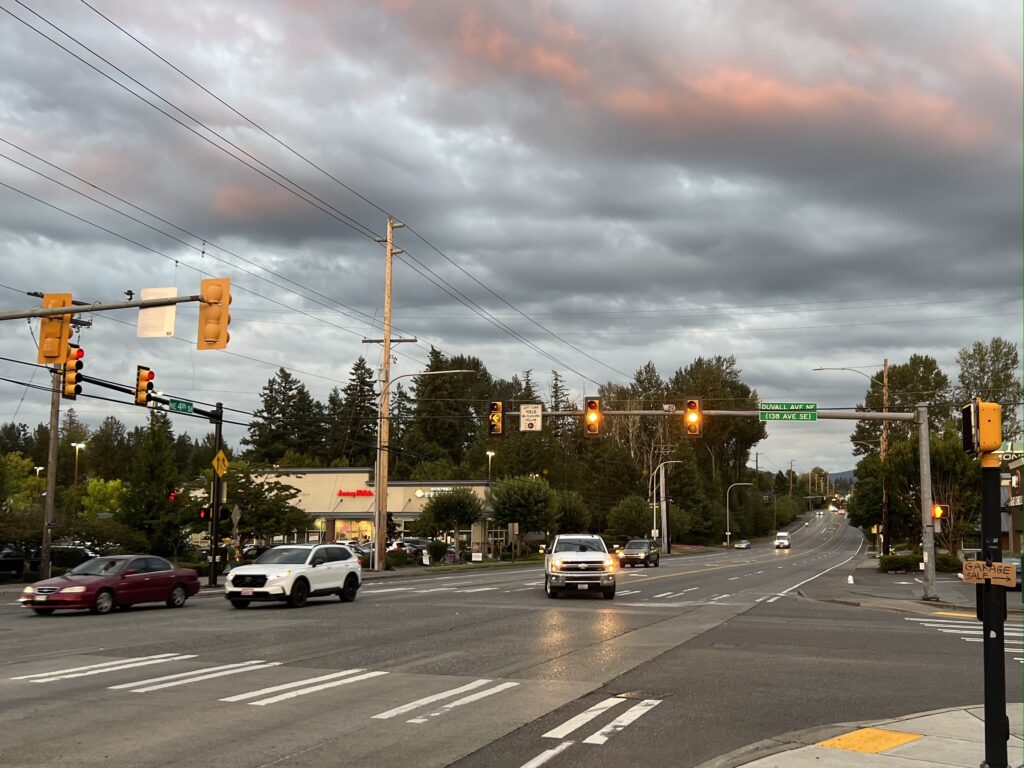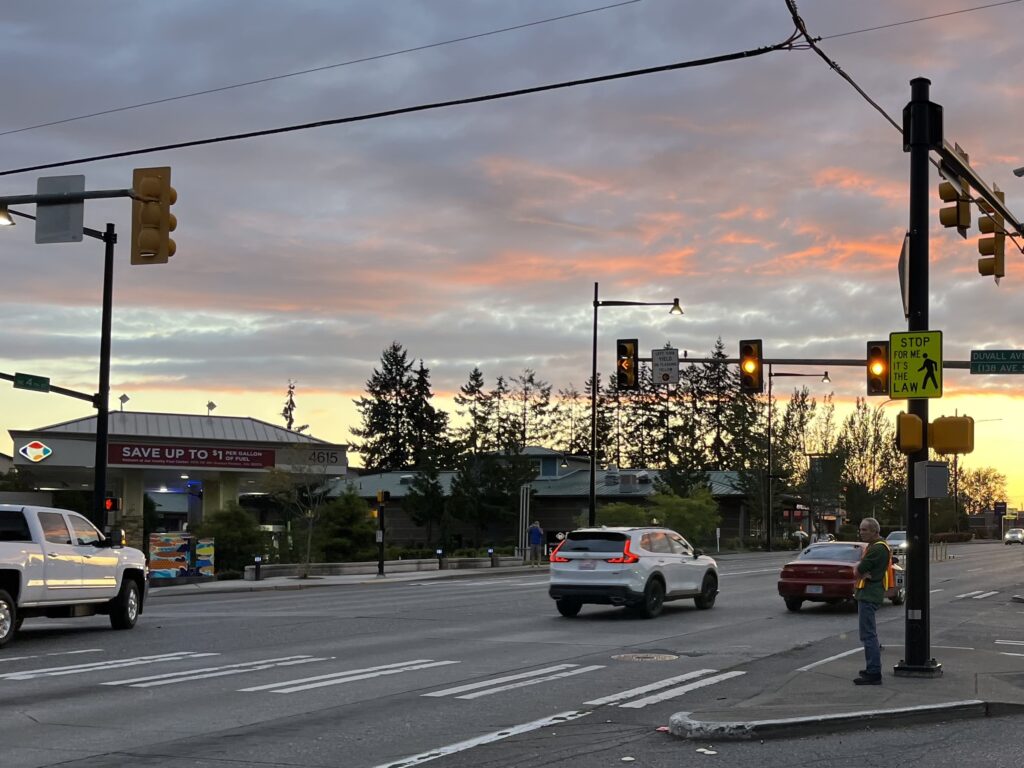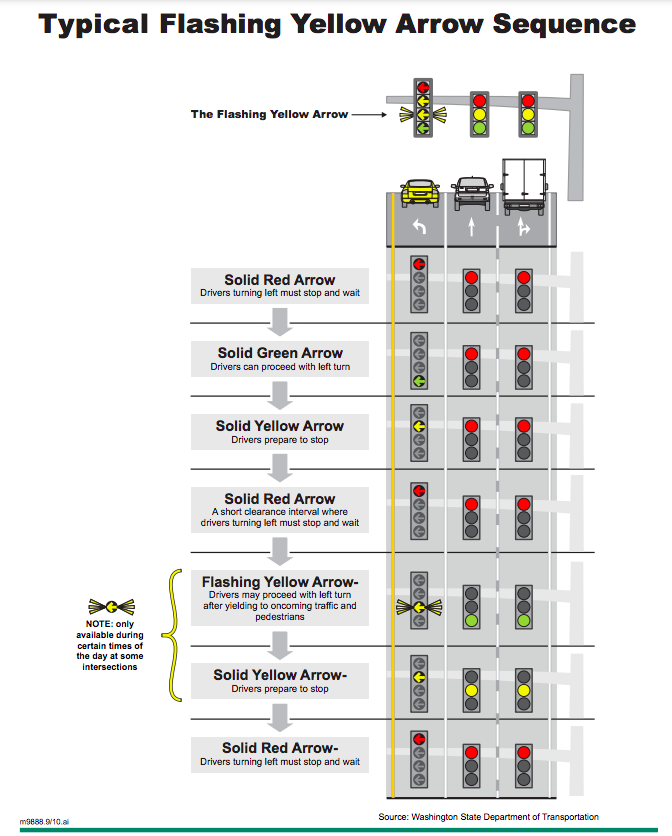
A collision September 6th at NE 4th Street and Duvall continues a frustrating pattern of frequent recent accidents at this intersection. Thankfully, drivers and passengers appeared to be able to walk away from this one. (Cause of this accident unknown at time of writing. Photo by Randy Corman)
There have been a lot of accidents at NE 4th and Duvall recently. Every collision is unique, and there are many potential root causes for each of these accidents; high speed, distraction, inattention, and other common driving errors are typically to blame. Some residents have questioned whether the flashing yellow left-turn arrows might be contributing. This question was also raised numerous times in Bellevue, which has been switching over to these flashing lights for years, and the Bellevue reporter covered the question thoroughly in 2015 in this article here.
These flashing arrows improve intersection efficiency and are in compliance with state and federal manuals. For maximum safety it is important for motorists to thoroughly understand these newer signaling arrangements to avoid errors that contribute to accidents.
In 2009 the Federal Highway Administration updated their Manual on Uniform Traffic Control Devices to allow flashing yellow arrows to replace circular green lights over lanes where left turns are allowed when safe (called permissive turning conditions). Both a circular green light and flashing yellow arrow mean the same thing in this case, but the flashing yellow arrow was found to be more intuitive for drivers, by reminding them to use caution and yield to oncoming traffic. (Note that only a green arrow indicates a protected left turn in which the left turn has right of way.)
Under the 2009 manual, the flashing arrow will briefly switch to a solid yellow arrow to mark the end of the permissive left turns for each traffic cycle, and this requires driver attention.
Most drivers already associate a solid yellow arrow with the short period following a green arrow, when drivers typically complete protected left turns and clear the intersection. In solid yellow arrows after green arrows, red lights are stopping oncoming traffic for the duration of the yellow arrow.
In contrast, the solid yellow arrow following a flashing yellow is NOT a protected left turn period. When a flashing yellow arrow switches to solid yellow, oncoming drivers’ traffic signals may still be yellow, and oncoming motorists may still be entering the intersection. So left-turning drivers must concentrate, and NOT make a reflexive left-turn just because their flashing yellow arrow turns to a solid yellow arrow. Motorists are advised not to enter the intersection on the flashing yellow unless they have good indication that there are no conflicting cars or pedestrian movements that will prevent them from safely completing their turn; and they should definitely not enter the intersection on the solid yellow following the flashing yellow.
It can also be disastrous if a driver is speeding down the street, spots a solid yellow left-turn arrow, and quickly executes the left turn thinking they can do it in a few seconds– if it is the solid yellow arrow marking the end of a permissive turning period, they will not have right of way.
In summary, if a motorist is waiting for an opportunity to turn at a flashing yellow arrow, and it turns to a steady yellow arrow, they should NOT assume traffic will immediately yield for them to complete their turn. And hurried motorists should not speed up to catch the yellow left-turn arrow and execute a quick left turn– they could cause a collision. All drivers should observe speed limits, understand the signals, and pay extra-close attention at busy intersections.

This photo, and the one below it, were taken at the exact same moment in time from opposite directions. Both directions of travel have solid circular yellow lights in the through lanes, and solid yellow arrows in the left turn lanes. If two motorists were speeding from opposite directions, trying to catch the yellow lights and not properly yielding, they could collide with each other if one is turning left and the other is going straight.

This photo, and the one above it, were taken at the exact same moment in time from opposite directions. This one is looking west. The turn arrow and circular lights are all solid yellow. My wife took this photo, and I can be seen across the street taking the photo above. (The cars shown safely and legally entered the intersection on green or yellow lights.)
The chart below shows how the arrow sequences work, and shows compatible adjacent lane signals. Oncoming traffic lanes will typically have matching signals. Note the difference in the adjacent lanes’ signals for the two different solid-yellow arrow cases. (Cars in other lanes are stopped for red in one case, and rushing to get through the yellow in the other.)

This chart can be found on the City of Bellevue’s website here
The excerpt below is out of the Federal Highway Administration Manual on Uniform Traffic Control Devices



Very good info. I always thought a green circle with a “left turn yield on green” was good, I wasn’t sure why they switched to flashing yellow arrows.
I’ve always thought this dangerous because makes the driver figure out the type of yellow arrow it was *before* it turns into a solid yellow arrow.
And frankly, not all of us are aware at all times. And many of us view a solid yellow as “get through the intersection fast.” Or, like me, has the attention span of a ferret.
Why not have an unprotected left yellow turn directly to red, or flashing red? If you’re in the intersection, you can still complete your turn per state law when appropriate. And if you’re not in the intersection, no harm done.
Either way would tell the driver that the light is changing, without potentially falsely giving them the idea that they have the right of way.
Doing a bit of digging, Minneapolis has been going back to yield on green with signage on new installations even though it violates their own state and federal guidance because they view it as safer. They call the problem the “yellow trap.”
Honestly, specific entitled drivers need a wake-up call to recognize the impact of their actions, and it seems some at 4th and Duvall just got theirs. Our streets, especially around that intersection, are shared spaces meant to accommodate everyone. Too often, the burden of safety is placed on pedestrians and marginalized communities, with BIPOC pedestrians bearing a disproportionate risk. Everyone needs to recognize that these issues aren’t isolated incidents; they tie into broader structural problems of inequity and disregard.
If drivers can’t or won’t adapt with a sense of responsibility, then we have to question if the “efficiency” they offer is worth the risk. Let’s not forget – it’s not just about abiding by traffic rules; it’s about ensuring that our communities have the right to move freely and safely on our streets.
Thanks SummerBoi for the comment. I agree with your sentiments that some drivers seem to feel too entitled; they speed through these intersections, disregarding the safety of others, including pedestrians and other drivers. When I was out taking my photos I felt some drivers were passing me going 50 miles an hour or more. I also agree some need a wake up call, but obviously we don’t want the wake up call to be an accident, since people can get so hurt, including innocent drivers who may be abiding by speed and other safety laws.
Nobody likes to get a speeding ticket, but this is why we have traffic patrol officers. As much as a ticket can spoil someone’s day, its a minor cost and inconvenience compared to a traffic accident– and it keeps people safe and alive for their loved ones. Lately the speeding drivers way outnumber the traffic officers, which I’m sure is exacerbating the problem.
I know some people have long grueling commutes, long work hours, distractions from cell phones, and many other daily challenges. But they should still be prepared to respectfully share the road, and take these busy intersections with caution. We should think of other users of the roads like our friends and family, and drive accordingly. We must look out for one another.
I agree that the standard circular light with the “left turn yield on green” signage seems the most consistent. The Federal Highway Administration was specifically working to address a known safety hazard where if you have a dedicated left turn lane, with arrows marking it as a left turn pocket, and a sign saying left turn only, then you illuminate a green circular light over it some people just go. So they tested the flashing yellow arrow against the green circular light and found the flashing yellow had fewer driver errors.
The challenge then is in how you indicate to drivers that the light is about to change to red. The traditional green standard circular light simply changes to yellow, and everyone understands this. To me, the flashing yellow arrow changing to a solid yellow error does not seem a perfect solution, because a solid yellow arrow already has a different meaning when it follows a green arrow– so some re-education is required. This problem is exacerbated by drivers speeding and trying to force their way through yellow lights to save time.
I agree that a flashing red arrow seems like it could have been a better choice than a solid yellow arrow, although I don’t know the extent of the testing that was done regarding this particular detail by the Federal Highway Administration. It’s possible that their engineers were concerned a flashing red might lead drivers to believe that oncoming traffic also had a red, which could lead to a driver turning in front of oncoming traffic.
One issue that adds complexity to this intersection on Duvall is that it is offering both protected left turns and unprotected left turns. This is good for efficiency, but requires driver concentration, which seems to be in short supply lately.
The full sequence for the left turn light is as follows:
solid red arrow…solid green arrow…solid yellow arrow…solid red arrow….flashing yellow arrow… solid yellow arrow…solid red arrow
In this sequence, the first solid yellow arrow is protected (motorists coming the other way are stopped), and the second solid yellow is unprotected (motorists coming the other way see a yellow light).
As far as I can tell, this is per the federal manual.
A major problem at 4th and Duvall is speed. Many drivers are speeding long before the intersection on 4th. They can’t or won’t slow down. If going east they speed even more. The rumble is clearly heard. I suggest a speed trap hide out in Scott Realty or adjacent storage driveway. That area is a dependable cash resource for the city. Westbound traffic on 4th turning south on Duvall by DQ is hazardous. The Duvall entry into DQ can completely stopped. The bushes at DQ entry/exit are also a hazard. Study surrounding areas at that intersection. It’s dangerous all around.
Thanks Darlene. I agree too many people drive way to fast on NE 4th Street. They seem to treat it as a high-speed highway instead of the busy business arterial that it is. As you point out, it has numerous driveways leading onto it, businesses surrounding it, and pedestrians crossing at every corner. For the sake of the safety of our community, I would also like to see the speeds more frequently patrolled, and I think your suggestions are very sensible. Some Renton PD officers read my blog, and will see your suggestions. I’ll also pass them along when I see them.
All these rules are taught to all new drivers but once they get their licenses out goes all the rules and regulations. Then of course when they see adult drivers doing illegal stuff then they think it is ok. I am dtill old school drive one car length ahead but guy behind never does. They’re right up my bumper many times i pull over to let ?them pass then they look at me funny.
I agree Pat. It’s important for experienced drivers to model safe driving behavior for younger drivers. Even if adults have exceptional judgement and driving reflexes, if they exhibit risky driving behavior, young people may try to copy them with disastrous results.
Like you, I also see too much tailgating. It actually slows traffic down by making maneuvers like merging more difficult, and it increases risk exponentially. Everyone should leave at least two seconds between their car and the car in front of them (at least that is what I was taught). I guess I’m pretty old school too.
I noticed that the Washington Drivers Guide does not describe the solid yellow following the flashing yellow as well as it could, although I can’t speak to how it is being taught in classes.
The Drivers Guide says “a yellow arrow means the protection of a green arrow is ending”, but it does not explain that a steady yellow arrow also means a flashing yellow arrow is ending. Drivers should still be able to figure it out, but in my opinion this wording could benefit from a small update.
Here is the whole paragraph covering traffic lights from page 3-2.
“A steady yellow traffic light means the traffic light is about
to change to red. You must stop if it is safe to do so. If you are
in the intersection when the yellow light comes on, do not stop
but continue through the intersection. A flashing yellow
traffic light means slow down and proceed with caution. A
yellow arrow means that the protection of a green arrow is
ending and if you are turning in the direction of the arrow, you
should prepare to stop and give the right-of-way to oncoming
traffic before turning. A flashing yellow arrow means left
turns are allowed, but you must yield to oncoming traffic
including bicyclists and pedestrians.”
https://www.dol.wa.gov/media/61/download?inline
A young fellow named Cody, 19, and a recent graduate of Liberty HS, lost his life at this intersection on 8-8-23. I hope this gets immediate attention. I can only imagine the pain his family is dealing with and the ladies in the vehicle he collided with.
Cody’s untimely passing at this intersection was a heartbreaking tragedy for our whole community. My heart goes out to his family and friends in this time of immense grief.